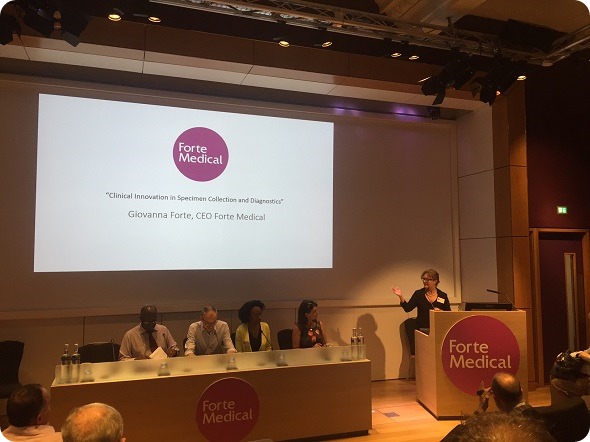As Dr Dawn Harper, GP and star of Embarrassing Bodies, stated at the Forte Medical Forum at the Royal Society of Medicine today:
Current urine sample collection pots were clearly designed by men for men”
An initial light-hearted opening comment perhaps, but it quickly became evident that there is an unmet need here. After hearing from Prof. Frank Chinegwundoh MBE, it was clear that it is not just the patient who doesn’t enjoy urine over their hands, healthcare professionals don’t relish touching a dripping sample pot either!
But this is about much more than just a hygiene issue and embarrassment factor. The studies outlined in the forum highlighted the contamination and retesting issues surrounding the wide variety of sample collection methods, for which there is currently no standard protocol in the UK, unlike with blood specimen collection.

As Urology Research Lead Linda Collins informed us, approximately 1 in 3 women will be treated for a UTI by the age of 24 years, consequently, this is a high volume issue. In fact, CEO of Forte Medical, Giovanna Forte reminded us that 65 million urine samples are collected and tested by the NHS every year.

Dr Vincent Forte invented urine collection method ‘Peezy Midstream’ back in 2001 after listening to female patients coming to his GP surgery for repeated urinary tract infections (UTIs). Dr Forte’s female patients described their undignified and downright messy urine collection methods.
Since then Peezy Midstream has evolved significantly and has made many advances, with the product now being available to buy on the NHS Supply Chain. Despite the success of Peezy Midstream, the Forte Medical Forum discussed the many challenges that lay ahead for a SME trying to bring an innovative product to the NHS.

Prof. James Barlow, Imperial College Business School, outlined many reasons why innovation is so important in healthcare from the ageing population to increasing lifestyle diseases. He also touched upon the big unknowns of antimicrobial resistance and the general impact of climate change on public health.
Despite this growing need for innovation, there still appear to be translation gaps that need to be addressed in order to improve the uptake for innovative products such as Peezy. Prof. Barlow claimed that it is still too easy for purchasers in the NHS to say “no”, but that the UK is not alone and such barriers exist across other countries. Prof. Barlow concluded by highlighting that it is often not the technology, but the organization that is the barrier.
In addition to such barriers, the forum highlighted practical issues that also need to be addressed in order for Peezy to be successful, such as Prof. Chinegwundoh story of a distressed male patient who had not been told to use Peezy over the toilet and thus had proceeded to wet his trousers! Clearly time is needed to explain to the patient how to use the device.
More revolutionary was Linda Collins’ talk of her research that questioned if we should only be using midstream urine collections and whether in fact important pathology information is being missed in the initial stream, which may contain bacteria that collect at the bottom of the bladder. While her research is still ongoing, it will be interesting to hear the final results of the study and whether Forte Medical will adjust Peezy to collect both initial and midstream urine in the future so that no informative part of the sample is missed.
In conclusion, September is Urology Awareness Month and so in addition to being a time for education about urology diseases, perhaps it is also a period in which we should be considering current urology protocols and how best to test and incorporate innovation.